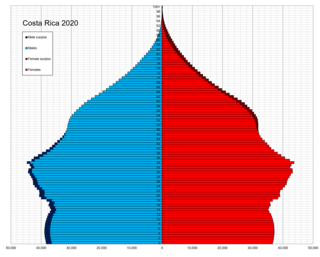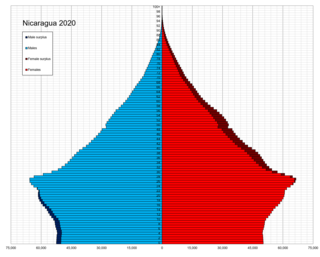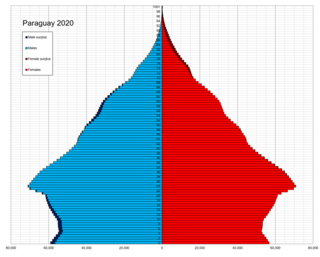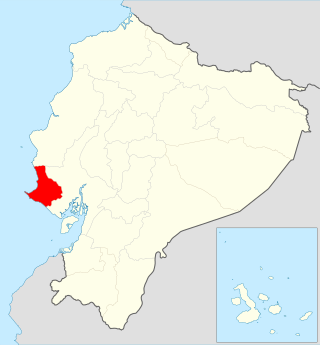
This is a demographic article about Costa Rica's population, including population density, ethnicity, education level, health of the populace, economic status, religious affiliations, and other aspects of the population.

This is a demography of the population of Guatemala including population density, ethnicity, education level, health of the populace, economic status, religious affiliations and other aspects of the population.

This article is about the ethnic groups and population of Honduras.

With a population of about 129 million in 2022, Mexico is the 10th most populated country in the world. It is the largest Spanish-speaking country in the world and the third-most populous country in the Americas after the United States and Brazil. Throughout most of the 20th century Mexico's population was characterized by rapid growth. Although this tendency has been reversed and average annual population growth over the last five years was less than 1%, the demographic transition is still in progress; Mexico still has a large youth cohort. The most populous city in the country is the capital, Mexico City, with a population of 8.9 million (2016), and its metropolitan area is also the most populated with 20.1 million (2010). Approximately 50% of the population lives in one of the 55 large metropolitan areas in the country. In total, about 78.84% of the population of the country lives in urban areas, and only about 21.16% in rural ones.

According to the 2022 revision of the World Population Prospects, Nicaragua has a population of 6,850,540..According to a 2014 research published in the journal Genetics and Molecular Biology, European ancestry predominates in 69% of Nicaraguans, followed by African ancestry in 20%, and lastly indigenous ancestry in 11%. A Japanese research of "Genomic Components in America's demography" demonstrated that, on average, the ancestry of Nicaraguans is 58–62% European, 28% Native American, and 14% African, with a very small Near Eastern contribution. Non-genetic data from the CIA World Factbook establish that from Nicaragua's 2016 population of 5,966,798, around 69% are mestizo, 17% white, 5% Native American, and 9% black and other races. This fluctuates with changes in migration patterns. The population is 58% urban as of 2013.

Demographic features of the population of Paraguay include population density, ethnicity, education level, health of the populace, economic status, religious affiliations and other aspects of the population.

Mestizo is a person of mixed European and indigenous non-European ancestry in the former Spanish Empire. In certain regions such as Latin America, it may also refer to people who are culturally European even though their ancestors are indigenous. The term was used as an ethno-racial exonym for mixed-race castas that evolved during the Spanish Empire. It was a formal label for individuals in official documents, such as censuses, parish registers, Inquisition trials, and others. Priests and royal officials might have classified persons as mestizos, but individuals also used the term in self-identification.

Mexicans are the citizens and nationals of the United Mexican States.

Filipinos are citizens or people identified with the country of the Philippines. The majority of Filipinos today are predominantly Catholic and come from various Austronesian peoples, all typically speaking Filipino, English, or other Philippine languages. Despite formerly being subject to Spanish colonialism, only around 2–4% of Filipinos are fluent in Spanish. Currently, there are more than 185 ethnolinguistic groups in the Philippines each with its own language, identity, culture, tradition, and history.

In the Philippines, Filipino Mestizo, or colloquially Tisoy, is a name used to refer to people of mixed native Filipino and any foreign ancestry. The word mestizo itself is of Spanish origin; it was first used in the Americas to describe people of mixed Amerindian and European ancestry. Currently and historically, the Chinese mestizos were and are still ordinarily the most populous subgroup among mestizos; they have historically been very influential in the creation of Filipino nationalism. The Spanish mestizos also historically and currently exist as a smaller population, but remain a significant minority among mestizos which historically enjoyed prestigious status in Philippine society during Spanish colonial times.

Chileans are an ethnic group and nation native to the country of Chile and its neighboring insular territories. Most Chileans share a common culture, history, ancestry and language. The overwhelming majority of Chileans are the product of varying degrees of admixture between European ethnic groups with peoples indigenous to Chile's modern territory. Chile is a multilingual and multicultural society, but an overwhelming majority of Chileans have Spanish as their first language and either are Christians or have a Christian cultural background.

Mexican settlement in the Philippines comprises a multilingual Filipino ethnic group composed of Philippine citizens with Mexican ancestry. The immigration of Mexicans to the Philippines dates back to the Spanish period.

The Ilustrados constituted the Filipino intelligentsia during the Spanish colonial period in the late 19th century. Elsewhere in New Spain, the term gente de razón carried a similar meaning.

Arenillas Canton is a canton of Ecuador, located in the El Oro Province. Its capital is the town of Arenillas. Its population at the 2001 census was 22,477.

Balao Canton is a canton of Ecuador, located in the Guayas Province. Its capital is the town of Balao. Its population at the 2010 census was 20,523.

Milagro Canton is a canton of Ecuador, located in the Guayas Province. Its capital is the town of Milagro. Its population at the 2001 census was 140,103.

Samborondón Canton is a canton of Ecuador, located in the Guayas Province. Its capital is the town of Samborondón. Its population at the 2001 census was 45,476.

Babahoyo Canton is a canton of Ecuador, located in the Los Ríos Province. Its capital is the town of Babahoyo. Its population at the 2001 census was 132,824.

Santa Elena Canton is a canton of Ecuador, located in the Santa Elena Province. Its capital is the city of Santa Elena. Its population at the 2010 census was 144,076.
In Mexico, the term mestizo is used to refer to an identity of those of mixed European and Indigenous Mexican descent. Some believe it can be defined by criteria ranging from ideological and cultural to self-identification, genetic ancestry, or physical appearance. According to these criteria, estimates of the number of mestizos in Mexico vary from about 40 percent of the population to over 90% who do not belong to the country's culturally indigenous minorities. A survey done by Latinobarometro in 2018 found that around 58% of Mexicans self-identify as mestizos when asked about their race, and another survey by Cohesión Social found that over 70% of Mexicans identified as mixed-race. Some genetic studies have claimed that mestizos make up over 93% of Mexico's present-day population, but this is disputed, with many Mexicans, including those of mixed ancestry, identifying more with static racial labels such as "white" or "indigenous" rather than mestizo, and a large number simply identifying as "Mexican," rejecting racialized labels.


















